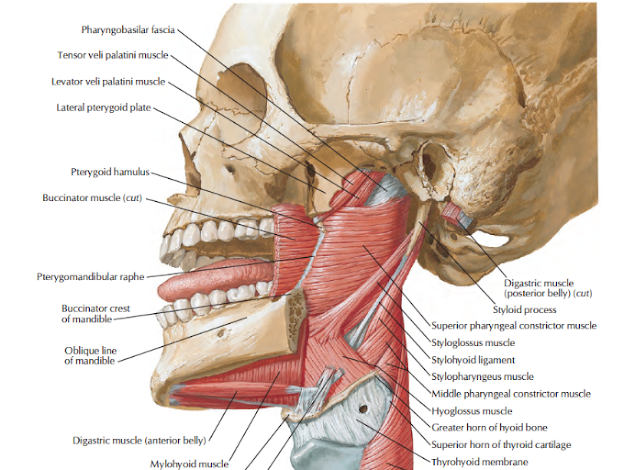- The styloid process with its attached structures is called the styloid apparatus.
- The structures attached to the process are three muscles and two ligaments.
- The muscles are the stylohyoid, styloglossus and stylopharyngeus
- and ligaments are the stylohyoid and stylomandibular
- The apparatus is of diverse origin.
- The styloid process/ the stylohyoid ligament and stylohyoid muscle are derived from the second branchial arch;
- the stylopharyngeus from the third arch;
- the styloglossus from occipital myotomes; and
- the stylomandibular ligament from a part of the deep fascia of neck.
- The five attachments resemble the reins of a chariot.
- Two of these reins (ligaments) are nonadjustable,
- whereas the other three (muscles) are adjustable and are controlled each by a separate cranial nerve, seventh, ninth and twelfth nerves.
- The styloid process is a long, slender and pointed bony process projecting downwards, forwards and slightly medially from the temporal bone.
- It descends between the external and internal carotid arteries to reach the side of the pharynx.
- It is interposed between the parotid gland laterally and the internal jugular vein medially.
- The styloglossus muscle arises from the anterior surface of the styloid process and is inserted into the side of the tongue.
- The stylopharyngeus muscle arises from the medial surface of the base of the styloid process and is inserted on the posterior border of the lamina of the thyroid cartilage.
- Stylohyoid extends between posterior surface of styloid process and hyoid bone.
- The stylomandibular ligament is attached laterally to styloid process above and angle of mandible below.
- The stylohyoid ligament extends from the tip of the stytoid process to the lesser cornua of the hyoid bone.
Features
1. External carotid artery crosses tip of styloid process superficially.
2. Facial nerve crosses the base of styloid Process laterally after it emerges from stylomastoid foramen.
Watch lectures on YouTube:








No comments:
Post a Comment